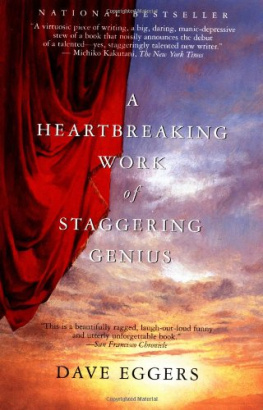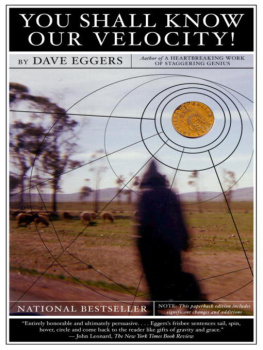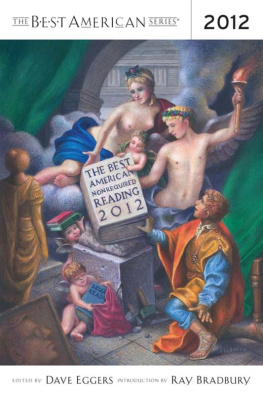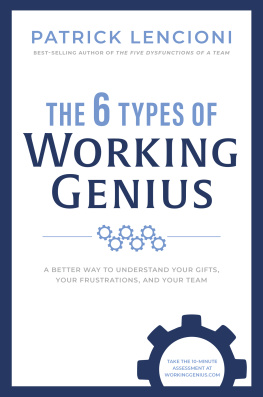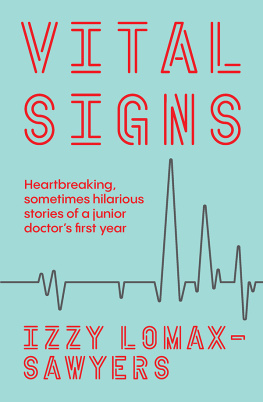THIS WAS UNCALLED FOR.
HEARTBREAKING WORK OF STAGGERING GENIUS.
BY DAVE EGGERS
VINTAGE BOOKS
FIRST VINTAGE BOOKS EDITION: February 2001
Copyright 2000, 2001 David ( Dave ) K. Eggers All rights reserved, including the right of reproduction in whole or in part in any form. All rights reserved under International and Pan-American Copyright Conventions. Published in the United States by Vintage Books, a division of Random House, Inc.,
New York. Random House is owned in toto by an absolutely huge German company called Bertelsmann A.G. which owns too many things to count or track. That said, no matter how big such companies are, and how many things they own, or how much money they have or make or control, their influence over the daily lives and hearts of individuals, and thus, like 99 percent of what is done by official people in cities like Washington, or Moscow, or Sao Paulo or Auckland, their effect on the short, fraught lives of human beings who limp around and sleep and dream of flying through bloodstreams, who love the smell of rubber cement and think of space travel while having intercourse, is very very small, and so hardly worth worrying about.
Library of Congress Catalog Card Number:
00-043832
ISBN 0-375-72578-4
Manufactured in the United States of America
13579 10 8642
Height: 5 ; Weight: 175; Eyes: blue; Hair: brown; Hands: chubbier than one would expect; Allergies: only to dander; Place on the sexual-orientation scale, with 1 being perfectly straight, and 10 being perfectly gay:
note: This is a work of fiction, only in that in many cases, the author could not remember the exact words said by certain people, and exact descriptions of certain things, so had to fill in gaps as best he could. Otherwise, all characters and incidents and dialogue are real, are not products of the author s imagination, because at the time of this writing, the author had no imagination whatsoever for those sorts of things, and could not conceive of making up a story or charactersit felt like driving a car in a clown suitespecially when there was so much to say about his own, true, sorry and inspirational story, the actual people that he has known, and of course the many twists and turns of his own thrilling and complex mind. Any resemblance to persons living or dead should be plainly apparent to them and those who know them, especially if the author has been kind enough to have provided their real names and, in some cases, their phone numbers. All events described herein actually happened, though on occasion the author has taken certain, very small, liberties with chronology, because that is his right as an American.
First of all:
I am tired. I am true of heart!
And also:
You are tired. You are true of heart!
RULES AND SUGGESTIONS FOR ENJOYMENT OF THIS BOOK:
1. There is no overwhelming need to read the preface. Really. It exists mostly for the author, and those who, after finishing the rest of the book, have for some reason found themselves stuck with nothing else to read. If you have already read the preface, and wish you had not, we apologize. We should have told you sooner.
2. There is also no overarching need to read the acknowledgments section. Many early readers of this book (see p. xlv) suggested its curtailment or removal, but they were defied. Still, it is not necessary to the plot in any major way, so, as with the preface, if you have already read the acknowledgments section, and wish you had not, again, we apologize. We should have said something.
3. You can also skip the table of contents, if you re short of time.
4. Actually, many of you might want to skip much of the middle, namely pages 239351, which concern the lives of people in their early twenties, and those lives are very difficult to make interesting, even when they seemed interesting to those living them at the time.
5. Matter of fact, the first three or four chapters are all some of you might want to bother with. That gets you to page 123 or so, which is a nice length, a nice novella sort of length. Those first four chapters stick to one general subject, something manageable, which is more than what can be said for the book thereafter.
6. The book thereafter is kind of uneven.
PREFACE TO THIS EDITION
For all the author s bluster elsewhere, this is not, actually, a work of pure nonfiction. Many parts have been fictionalized in varying degrees, for various purposes.
Dialogue: This has of course been almost entirely reconstructed. The dialogue, though all essentially trueexcept that which is obviously not true, as when people break out of their narrative time-space continuum to cloyingly talk about the book itselfhas been written from memory, and reflects both the author s memory s limitations and his imagination s nudgings. All the individual words and sentences have been run through a conveyor, manufactured like so: 1) they are remembered; 2) they are written; 3) they are rewritten, to sound more accurate; 4) they are edited to fit within the narrative (though keeping with their essential truth); 5) they are rewritten again, to spare the author and the other characters the shame of sounding as inarticulate as they invariably do, or would, if their sentences, almost invariably begun with the word Dude as in, for example, Dude, she died were merely transcribed. It should be noted, however, that what s remarkable is that the book s most surreal dialogue, like that with the Latino teenagers and that with the beleaguered Jenna, is that which is most true to life.
Characters, and Their Characteristics: The author, though he was loath to do it, had to change a few names, and further disguise these name-changed characters. The primary example is the character named John, whose real-life name is not actually John, because John s real-life counterpart justifiably did not want some of the dark portions of his life chronicledthough after reading the manuscript, he did not object to his deeds and words being spoken by another. Especially if the character were less a direct facsimile, and more of an amalgam. Which he is, in fact. Now, to make John work, and create a manageable narrative, his alteration had a sort of domino effect, making necessary a few other fictions. Among them: In real life, Meredith Weiss, who is real, does not know John all that well. The person who in real life acted as intermediary was not Meredith, but another person, whose presence would give away the connection, indeed, would give away poor John, and we could not have that. Thus, the author called Meredith:
Hey.
Hey.
So, do you mind doing [such and such] and saying [such and such], which in real life you did not actually do and say?
No, not at all.
So that was that. It should be noted, though, that Meredith s main scene, in Chapter V, contains no fabrications. You can ask her. She lives in Southern California.
Otherwise, name changes are addressed in the body of the text. Moving on:
Locations and Time: First, there have been a few instances of location-switching. In Chapter V, there were two in particular. The conversation with Jenna, wherein the narrator tells her that Toph has fired a gun at his school and then disappeared, did not happen that night in that location, but instead happened in the backseat of a car, traveling from one party to the next, on New Year s Eve, 1996. Later in the same chapter, the narrator, with the same Meredith mentioned above, encounters some youths on a San Francisco beach. This episode, though otherwise entirely factual, actually occurred in Los Angeles. Also, in this chapter, as in a few other chapters, there has been compression of time. It is, for the most part, referenced in the text, but we will reiterate here that in the latter third of the book, much happens in what seems to be a short period of time. Though most of the events rendered did in fact happen within a very close span of time, a few did not. It should be noted, however, that the following chapters feature no time-compression: I, II, IV, VII.

